Revista Mexicana de Ciencias Geológicas, v. 42, núm. 1, abril 2025, p. 17–30

The metamorphic configuration of the Piaxtla high-pressure suite inferred from geological mapping and its metasedimentary rocks
Roberto Maldonado1, Mariano Elías-Herrera1, Guillermo Espejo-Bautista2, Israel Ramírez-Serdán3, Duban Esteban Gomez-Gomez4, Angela Prado-Ordoñez3, Consuelo Macías-Romo1, and José Luis Sánchez-Zavala1
1Instituto de Geología, Universidad Nacional Autónoma de México, Mexico City, Mexico.
2Instituto de Geociencias, Universidad Nacional Autónoma de México, Campus Juriquilla, Mexico.
3Facultad de Ciencias, Universidad Nacional Autónoma de México, Mexico City, Mexico.
4Posgrado en Ciencias de la Tierra, Instituto de Geociencias, Universidad Nacional Autónoma de México, Mexico City, Mexico.
Corresponding author (R. Maldonado): robertom@geologia.unam.mx
ABSTRACT
The Piaxtla high-pressure suite (Acatlán Complex) in southern Mexico represents a part of an ancient subduction zone. This suite consists of slices of oceanic and continental affinity containing blueschist- and eclogite-facies relics. Geological mapping of three key areas showed that rocks and mineral assemblages vary systematically and predictably across the region allowing us to divide the Piaxtla suite into two different low- and medium-temperature units (i.e., blueschist- and eclogite-facies, respectively). Field relationships suggest that rock intercalation within each unit resulted from an early subduction-related deformation stage (D1) subsequently overprinted by two deformation phases (D2 and D3). In the high-pressure–low-temperature unit, metasedimentary rocks are predominant and compositionally heterogeneous and share a common high-pressure history with the enclosed blueschists. The high-pressure–medium-temperature unit is characterized by the abundance of granitic gneisses as well as a relatively homogeneous metasedimentary package that is also co-metamorphic with the hosted eclogites. Together, field relationships and petrography indicate that low- and medium-temperature units within the Piaxtla high-pressure suite might have evolved as independent, relatively coherent tectonic slices.
Keywords: Geological mapping; petrography; high-pressure metamorphism; subduction; Acatlán Complex; Piaxtla suite; Paleozoic; Mexico.
RESUMEN
La suite de presión alta Piaxtla (Complejo Acatlán) en el sur de México representa parte de una zona de subducción antigua. Esta suite consiste en fragmentos de afinidad oceánica y continental que contienen relictos en facies de esquisto azul y eclogita. El mapeo geológico de tres áreas clave mostró que las rocas y las asociaciones minerales varían sistemáticamente y de forma predecible, permitiendo dividir la suite Piaxtla en dos diferentes unidades de temperatura baja y media (i.e., facies de esquisto azul y eclogita, respectivamente). Las relaciones de campo sugieren que la intercalación de rocas dentro de cada unidad resultó de una primera etapa de deformación relacionada con la subducción (D1), la cual se vio afectada por dos fases de deformación subsecuentes (D2 y D3). En la unidad de presión alta y temperatura baja, las rocas metasedimentarias son predominantes y composicionalmente heterogéneas, y comparten una historia común a presión alta con los esquistos azules que contienen. La unidad de presión alta y temperatura media se caracteriza por la abundancia de gneises graníticos y por una secuencia metasedimentaria relativamente homogénea que también es co-metamórfica con las eclogitas asociadas. En conjunto, las relaciones de campo y los datos petrográficos indican que las unidades de temperatura baja y media de la suite Piaxtla pudieron haber evolucionado como fragmentos tectónicos independientes relativamente coherentes.
Palabras clave: mapeo geológico; petrografía; metamorfismo de presión alta; subducción; Complejo Acatlán; suite Piaxtla; Paleozoico; México.
Corrected manuscript received: December 6, 2024
Manuscript accepted: December 10, 2024
Published Online: April 1, 2025
INTRODUCTION
The Acatlán Complex represents one of the largest exposures of Paleozoic rocks and arguably the most studied basement unit in Mexico. A remarkable feature of this complex is that it contains a high-pressure (HP) metamorphic suite (Piaxtla HP suite) representing a fragment of a fossil subduction zone of Mississippian age (Middleton et al., 2007; Keppie et al., 2010; Ramos-Arias et al., 2012; Estrada-Carmona et al., 2016). In the last two decades, the HP suite has been the subject of numerous studies providing a relatively large set of published geochronological, geochemical, and petrological data (e.g., Ortega-Gutiérrez et al., 1999; Meza-Figueroa et al., 2003; Talavera-Mendoza et al., 2005; Murphy et al., 2006; Vega-Granillo et al., 2007; Keppie et al., 2010, 2012b; Galaz E. et al., 2013; Hernández-Uribe et al., 2019). The abundance of analytical information, however, contrasts with the lack of detailed geological maps for most of the HP suite exposures, including the type area to the south of the village of Piaxtla. In addition, the majority of lithological descriptions have focused on the mafic and granitic components of the sequence, while the metasedimentary rocks, which host most of the blueschist and eclogite occurrences, have received little attention. Producing geological maps describing the nature and spatial relationships of rocks is an essential starting point for determining the architecture of subduction complexes and evaluating the mechanisms of their assembly (e.g., Compagnoni et al., 2012; Balestro et al., 2020). The metamorphic configuration of subduction complexes may provide important clues about the thermal structure, physical interactions and geochemical cycles at the subduction plate interface (e.g., Agard et al., 2018). In this contribution we present geological maps, field data, and petrographic descriptions of metasedimentary rocks from three key areas across the northern part of the HP suite (Figure 1). We also review and discuss the field information available for this unit and propose a simple nomenclature with a metamorphic connotation. In doing so, we aim to provide a cartographic base that can serve as a reference for carrying out detailed structural and petrological studies.
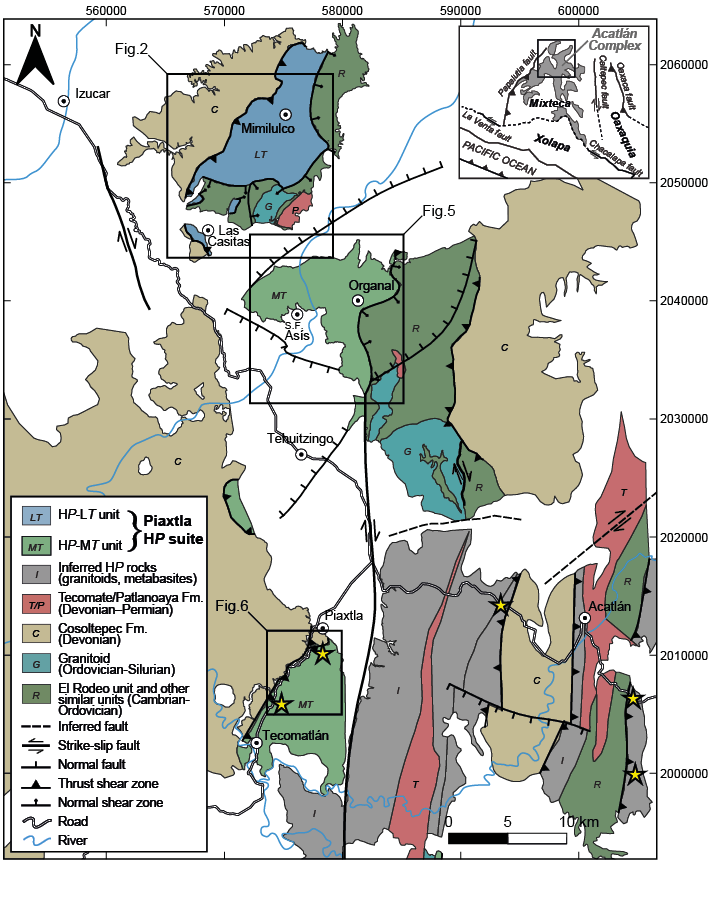
Figure 1. Regional geological map showing the location of the Piaxtla high-pressure suite in the northern Acatlán Complex (modified after Vega-Granillo et al., 2007; Ramos-Arias et al., 2008; Hinojosa-Prieto et al., 2008; Ortega-Gutiérrez et al., 2018). The rectangles indicate the areas mapped in this work. Stars highlight localities where either eclogite or eclogite-facies relics were firstly reported by Ortega-Gutiérrez (1974). HP: high pressure; LT: low temperature; MT: medium temperature.
GEOLOGICAL FRAMEWORK
The HP suite occurs in a main NS-elongated belt along the Mimilulco-Tecomatlán sector of the Acatlán Complex (Figure 1), and as a klippe derived from this belt in the Ixcamilpa region (Ramos-Arias & Keppie, 2011; Keppie et al., 2012a). Previous reports of eclogite-facies relics (Ortega-Gutiérrez, 1974) suggest that several other fault-bounded slices of the HP suite may exist to the east of the main belt. The stratigraphical nomenclature and subdivisions developed over half of a century for this HP belt (e.g., Ortega-Gutiérrez, 1978; Murphy et al., 2006; Vega-Granillo et al., 2007; Ramos-Arias & Keppie, 2011) have been varied and often confusing. Here we will use the term Piaxtla HP suite (or simply the HP suite) in the sense of Keppie et al. (2012b) to refer to the complete set of rocks that underwent HP metamorphism. The Piaxtla HP suite consist of a sequence of alternating mica schists, granitoid gneisses, metabasites with epidote blueschist- and eclogite facies relics, and serpentinites, which represent: (1) Neoproterozoic–Ordovician (<982, >440 Ma) metasediments intercalated with MORB-like metabasites (retrogressed blueschist and eclogite), (2) Ordovician–Silurian (488–440 Ma) bimodal rift-related intrusions (retrogressed eclogite, metagranitoid) that are broadly coeval with volcaniclastic metasediments, (3) supra-subduction ultramafic bodies, and possibly (4) post-Silurian
(<365 Ma) metasediments (Proenza et al., 2004; Sánchez-Zavala et al., 2004; Talavera-Mendoza et al., 2005; Murphy et al., 2006; Vega-Granillo et al., 2007; Nance et al., 2009; Ramos-Arias & Keppie, 2011; Keppie et al., 2012b; a; Galaz E. et al., 2013).
Available pressure-temperature (P-T) estimates of HP metamorphism vary considerably depending on the author and method used (e.g., Meza-Figueroa et al., 2003; Vega-Granillo et al., 2007; Galaz E. et al., 2013). However, recent P-T data based on Zr-in-rutile thermometry and phengite Si-isopleth barometry indicates that eclogites followed a clockwise P-T path with peak conditions at ~22 kbar and ~690 °C, whereas epidote blueschists experienced a similar trajectory with peak metamorphic conditions at ~19–13 kbar and ~500 °C (Hernández-Uribe et al., 2019). According to Hernández-Uribe et al. (2019), previous P-T data might be over- or underestimations or probably reflect re-equilibration conditions.
Geochronological data are also variable depending on the rock type and isotope-mineral system used. Most of the available dates were obtained by the Ar-Ar method on white mica or amphibole and range mainly between 346 and 318 Ma (Vega-Granillo et al., 2007; Keppie et al., 2010, 2012b; Ramos-Arias et al., 2012), reflecting the cooling history of the HP suite. Ages that can be attributed to the prograde and peak stages range between ca. 353 and 344 Ma, and were obtained by glaucophane Ar-Ar, zircon U-Pb, and garnet/whole-rock Lu-Hf geochronology (Middleton et al., 2007; Keppie et al., 2010; Estrada-Carmona et al., 2016). A minor group of zircon U-Pb dates obtained in migmatized rocks suggests that the initial exhumation of the HP suite occurred between 348 and 330 Ma (Middleton et al., 2007; Keppie et al., 2012a).
METHODOLOGY
The mapped areas comprise vegetated and agricultural land, where most lithologies have a limited exposure of about 10–20%. Despite this limitation, the generally homogeneous outcrop distribution and the relative consistency of the compositional layering and composite metamorphic foliations allowed us to produce reliable interpretative geological maps. The study areas were originally mapped at the 1:20,000 scale. Both the original data and the maps presented in this work are represented using the 1:50,000 vector databases (edition 2019) provided by the Instituto Nacional de Estadística y Geografía (INEGI). Field and vector data management was performed using the QGIS 3.8 software. Coordinates used in the maps are referred to the UTM (14N)-ITRF2008/WGS84 reference system. For the sake of clarity, Mesozoic and Cenozoic deposits covering an area of 10–50% in the interpretative geologic maps, have been omitted.
The distinction between tectonometamorphic units formed at different pressure and temperature conditions is only possible if the geologic survey is assisted with an extensive sampling and a detailed petrographic study. Petrographic descriptions are based on examination of 65 samples under a standard optical polarizing microscope, including representative samples of the spatially related metabasites and granitic gneisses. The information of the samples, including location, rock type, and mineral assemblages is provided in the Supplementary Table S1.
FIELD DATA
The northern part of the Piaxtla HP suite occurs as a discontinuous NS belt with kilometer-scale exposures in the Mimilulco-Las Casitas, San Francisco de Asís-Organal, and Piaxtla-Tecomatlán areas (Figure 1). The metamorphic sequence can be described in terms of two lithologically distinct units: (1) A blueschist-bearing HP-low temperature (LT) unit exposed in the Mimilulco-Las Casitas area, and possibly extended into a part of the area of Piaxtla-Tecomatlán, and (2) an eclogite-bearing HP-medium temperature (MT) unit extending over the San Francisco de Asís-Organal and Piaxtla-Tecomatlán areas.
HP-LT unit (blueschist-bearing)
The HP-LT unit defines a NE-SW belt up to 8 km wide that is bounded on either side by poly-deformed sequences composed of low-grade psammitic-pelitic and mafic schists (Figure 2). On the western side, the contact is a steeply dipping shear zone (here referred to informally as the Lagunilla thrust) displaying subhorizontal (dextral) and subvertical slickenlines as well as N-verging folds, where the HP-LT unit overlies a low-grade metasedimentary sequence assigned to the Cosoltepec Formation (Ortega-Gutiérrez et al., 1999). The eastern-southern margin is an ESE-dipping normal shear zone (Ahuatlán fault) that separates the HP-LT unit from pre-Upper Ordovician rocks grouped into various lithodemic units (Ramos-Arias et al., 2008), formerly denoted as the El Rodeo Formation/suite (Talavera-Mendoza et al., 2005; Vega-Granillo et al., 2007).
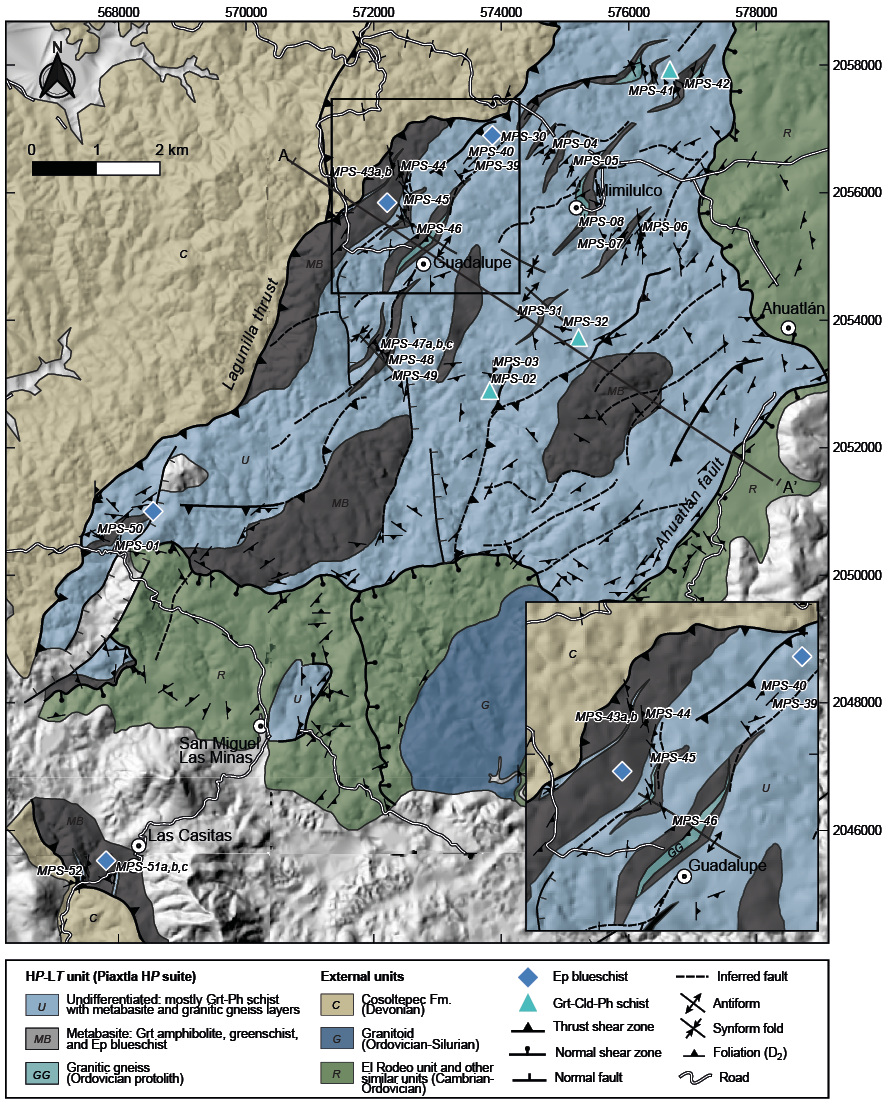
Figure 2. Geological map of the high-pressure–low-temperature unit in the Mimilulco-Las Casitas area, with inset showing a close-up view around the Guadalupe village. Sample locations are indicated in cursive. Cross section A-A' is shown in Figure 3. HP: high pressure; LT: low temperature; Grt: garnet; Ph: phengite; Cld: chloritoid; Ep: epidote.
The HP-LT unit consists of a series of phengite schist alternating with layers of metabasite and, to a lesser extent, granitic gneiss (Figure 3 section A-A', Figure 4). This sequence displays at least three phases of deformation including foliation development and folding. The oldest structures (D1) consist of foliation and banding defined by the alignment and segregation of minerals formed during prograde HP-LT metamorphism. Additionally, D1 is represented by rock contact surfaces producing concordant lithological layering of the HP-LT unit. A second phase of deformation (D2) is defined by isoclinal asymmetric folding of D1 structures and development of a penetrative axial plane foliation. The youngest phase of deformation (D3) produced asymmetrical gently recumbent open folding (NE vergence) and crenulation cleavage affecting D2 structures.
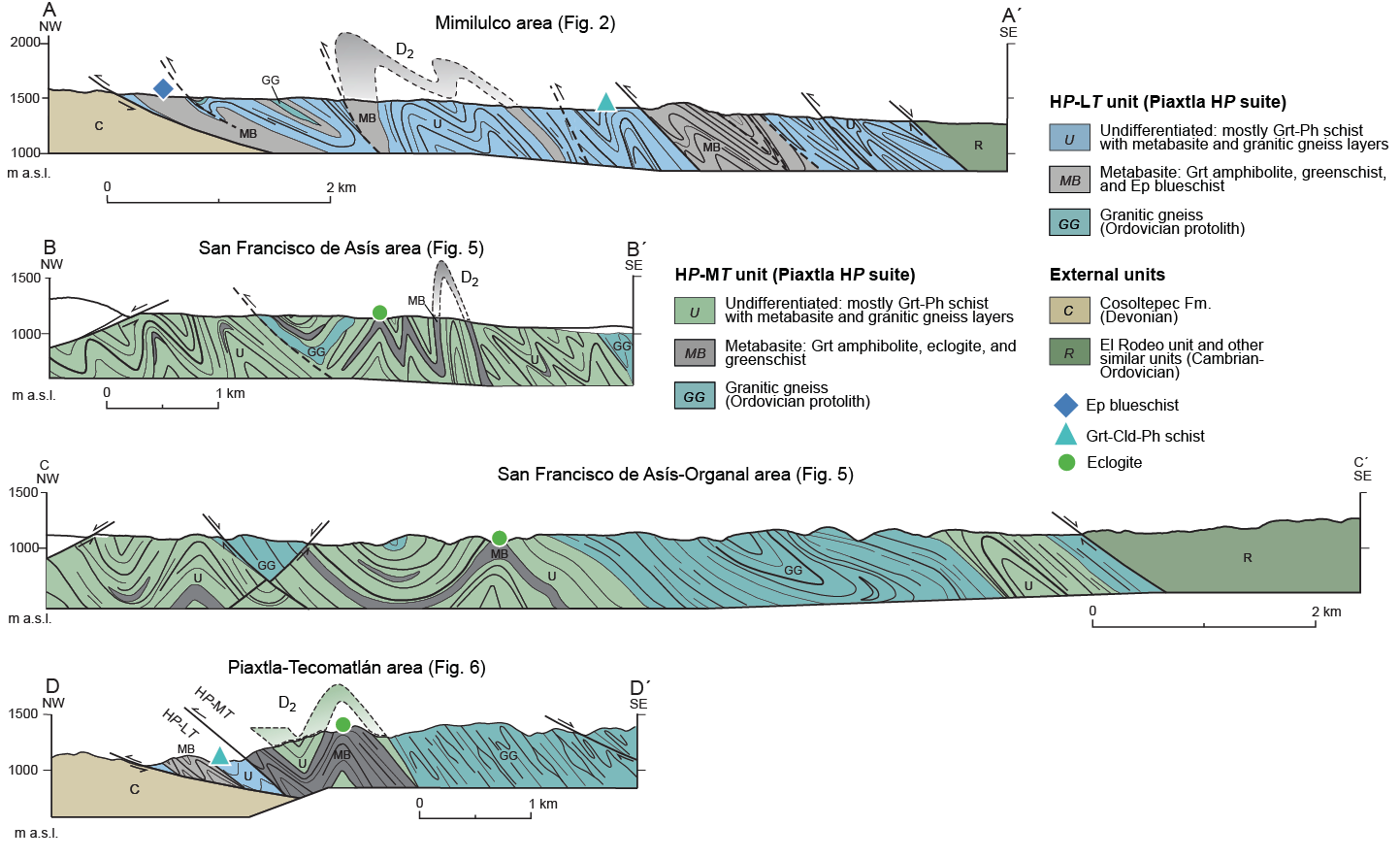
Figure 3. Representative geological cross sections of the Piaxtla high-pressure suite. Section A-A' corresponds to the high-pressure–low-temperature unit in the Mimilulco area (Figure 2). Sections B-B' and C-C' describe the high-pressure–medium-temperature unit exposed in the San Francisco de Asís-Organal area (Figure 5). Section D-D' is located in the Piaxtla-Tecomatlán area (Figure 6). HP: high pressure; LT: low temperature; MT: medium temperature; Grt: garnet; Ph: phengite; Cld: chloritoid; Ep: epidote.
Most of the phengite schist sequence varies at the meter scale between garnet-phengite schist and albite-phengite schist (Figures 4a, 4b), most of which are characterized by the abundance of millimeter-sized phengite and garnet porphyroblasts up to 2 cm in diameter. Tourmaline is commonly observed at the hand-specimen scale. Albite-rich layers also contain an observable amount of epidote-clinozoisite and amphibole. One remarkable rock type within this sequence is coarse-grained garnet-chloritoid-phengite schist (Figure 4c) cropping out as a NE-SW-trending layer, tens of meters thick, along the middle portion of the HP-LT belt. Chloritoid-bearing phengite schists were also found in the Piaxtla-Tecomatlán area (see below). Another distinctive lithology is garnet-hematite-phengite schist (black schist), which occurs as meter-thick layers and is commonly found adjacent to blueschist occurrences. Minor volumes of garnet paragneiss grading into quartzite, as well as calc-schist are also present in the HP-LT unit as centimeter- to meter-thick intercalations (Figure 4d). The phengite schist sequence commonly contains quartz segregations in form of bands and lenses up to 30 cm thick, and more rarely, centimeter-scale leucocratic domains.
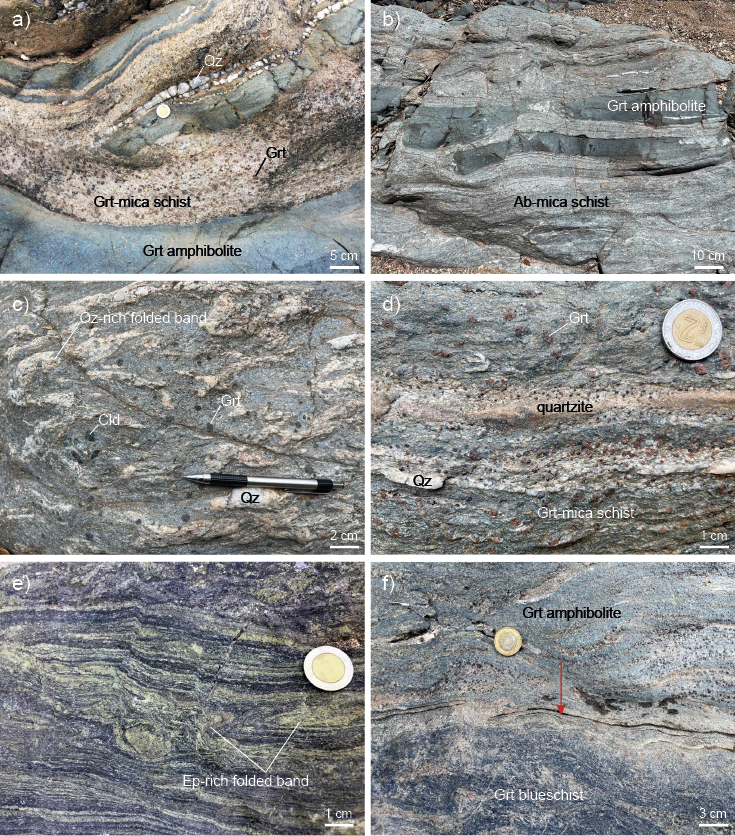
Figure 4. Outcrop photographs of the high-pressure–low-temperature rocks of the Piaxtla suite showing different compositions and field relationships. (a) Coarse-grained garnet-phengite schist showing centimeter-thick bands of green garnet amphibolite (near El Carrizo village). (b) Albite-phengite schist with centimeter-thick discontinuous intercalations of garnet amphibolite (north from Guadalupe). (c) Coarse-grained garnet-chloritoid-phengite schist showing folded and detached quartz-rich bands (near El Carrizo village). (d) Centimeter-scale intercalations of coarse-grained garnet-phengite schist and fine-grained garnet-bearing quartzite (Mimilulco). (e) Folded blueschist displaying epidote segregations in the form of thin layers and lenses (north of Guadalupe). (f) Retrogression of a garnet blueschist into green garnet amphibolite. The red arrow indicates the retrogression front (Las Casitas village). Ab: albite, Cld: chloritoid, Ep: epidote, Grt: garnet, Qz: quartz.
Metabasites occur as layers and lenses centimeter to hundreds of meters thick. These include garnet amphibolite, greenschist, and epidote blueschist (Figure 4e), displaying concordant contacts with the host metasediments (Figures 4a, 4b). The spatial relationships among these metabasite types are visible in places where blueschists are observed to be variably retrogressed under greenschist-facies conditions. For instance, at Las Casitas village, ca. 3 km southwest of San Miguel Las Minas, garnet-bearing blueschists change gradually into green garnet amphibolite at the outcrop scale (Figure 4f) or even into greenschist in high-strain mylonitic zones. Several bands of garnet amphibolite in the Mimilulco area contain millimeter- to centimeter-long zoisite porphyroblasts. Some metabasite bodies exhibit patches and veinlets of plagioclase-rich material.
Granitic gneisses are uncommon and occur as layers tens of meters thick that are typically interleaved with metabasites, and locally show preserved cross-cutting relationships with the phengite schist sequence. These rocks contain millimeter-sized flakes of phengite, biotite and chlorite, and may alternate mesoscopically with garnet-bearing meta-leucogranites.
HP-MT unit (eclogite-bearing)
The HP-MT unit in the San Francisco de Asís-Organal area (Figure 5) occurs as a kilometer-scale overturned (NW-verging) fold structure that is fault-bounded to the east by a sequence of slate and meta-volcanic rocks hosting megacrystic Ordovician granitoids (Miller et al., 2007). The contact is defined by an ESE-dipping shear zone (here referred to as the Cuayuca fault), which displays sigmoidal structures indicating normal shearing, as well as (later?) subhorizontal slickenlines. The boundaries in other directions are hidden below Cenozoic deposits (Silva-Romo et al., 2018). In particular, the contact with the HP-LT unit, which should exist on the northwestern side, is obscured by recent sub-volcanic intrusions and pyroclastic rocks. In the Piaxtla-Tecomatlán area, the HP-MT unit forms a NE-SW-elongated belt, 2–10 km wide, that tectonically overlies on the western side a possible slice of the HP-LT unit (Figure 3 section D-D'; Figure 6), which in turn is thrust over poly-deformed slates and quartzites belonging to either the Cosoltepec Formation (Ortega-Gutiérrez et al., 1999) or to an Ordovician metasedimentary unit (Galaz E. et al., 2013). The eastern boundary of the HP-MT unit could not be established and might extend further east to the Acatlán area.
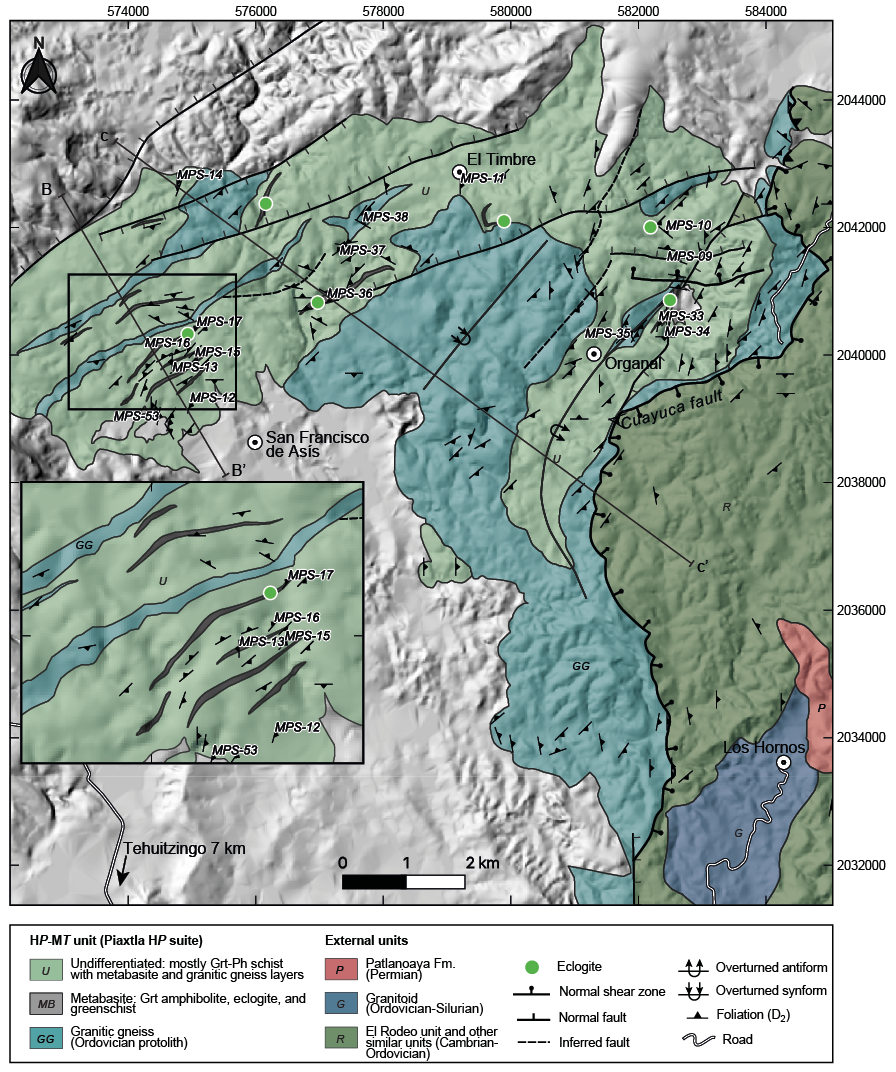
Figure 5. Geological map of the high-pressure–medium-temperature unit in the San Francisco de Asís-Organal area, with inset showing a close-up view northwest from the San Francisco de Asís village. Sample locations are denoted in cursive. Cross sections B-B' and C-C' are presented in Figure 3. HP: high pressure; MT: medium temperature; Grt: garnet; Ph: phengite.
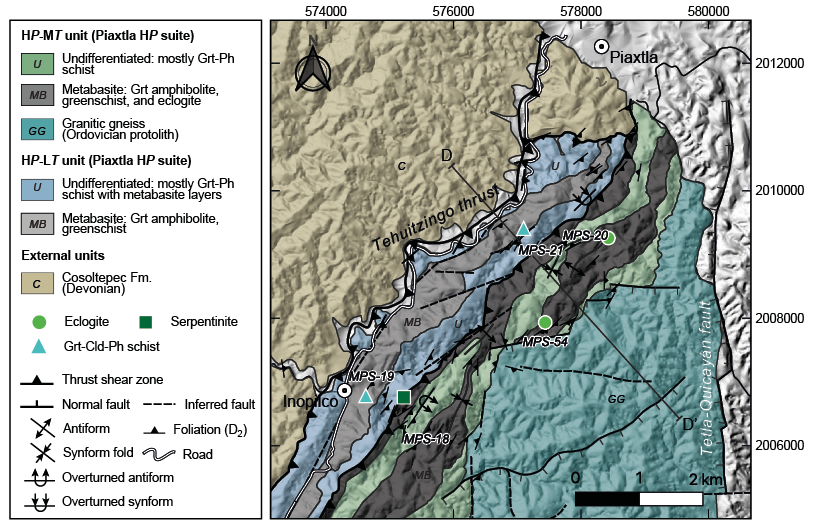
Figure 6. Geological map of the northern Piaxtla-Tecomatlán area. Note the probable limit between the high-pressure–low-temperature unit (west) and the high-pressure–medium-temperature unit (east). The limit on the western side of the Piaxtla high-pressure suite is considered to be a southern extension of the Tehuitzingo thrust (Galaz E. et al., 2013). Sample locations are indicated in cursive. Cross section D-D' is shown in Figure 3.
HP: high pressure; LT: low temperature; MT: medium temperature; Grt: garnet; Ph: phengite; Cld: chloritoid.
The HP-MT unit is formed by an assemblage of phengite schist, para- and orthogneiss, metabasite, and serpentinite recording a polyphase deformation history that is similar to that in HP-LT rocks. First-phase structures (D1) include foliation and centimeter- to meter-scale layering developed during prograde HP-MT metamorphism. Phase two structures (D2) define the dominant foliation of the unit, associated with tight to isoclinal folding of D1 with a predominant N-NW vergence. Structures generated during a third phase of deformation (D3) vary from meso- to macroscopic scale and are defined by open folds that affect the D2 axial plane foliation. D3 folds are upright to inclined and plunge gently to moderately north or south.
Metasedimentary rocks show meso- to macroscopic lithologic variations, comprising a predominant garnet-quartz-phengite schist sequence with intercalations of quartz-rich gneiss and quartzite (Figure 7a). Garnet-quartz-phengite schists contain variable amounts of visible plagioclase and tourmaline, as well as garnet that forms millimeter- to centimeter-sized porphyroblasts (Figures 7b, 7c). These rocks are commonly migmatized, displaying a stromatic structure with centimeter-thick layers of leucocratic neosome. Abundant centimeter-thick bands and lenses of quartz are also characteristic of this phengite schist sequence. Contacts between the metasedimentary package and the adjacent granitic gneisses are mostly sharp and fabric parallel, being either concordant with respect to D1–D2 structures or faulted (Figure 7d). Some gradational contacts are observed associated with lenses (xenoliths) of metasedimentary rocks within the granitic gneisses, suggesting that the original intrusive relationships are locally preserved.

Figure 7. Outcrop photographs of the high-pressure–medium-temperature unit showing field relationships and compositional variations among metasedimentary rocks. (a) Centimeter-scale intercalations of quartzite, garnet-quartz-phengite schist, and quartz-rich gneiss (northeast from Organal). (b) Medium-grained garnet-quartz-phengite schist showing millimeter-sized garnet and phengite, as well as patches of leucocratic neosome (northeast from San Francisco de Asís). (c) Coarse-grained garnet-quartz-phengite schist displaying centimeter-sized garnet porphyroblasts rimmed by chlorite (Piaxtla area). (d) Tectonized contact between a quartz-rich gneiss and a layer of granitic gneiss (Organal). (e) Garnet-quartz-phengite schist hosting a centimeter-thick lens of partially retrogressed eclogite. The red arrow indicates the retrogression front. Note the migmatization of the sequence, with relatively in situ neosome patches in both the schist and the eclogite. (f) Fresh eclogite with millimeter-sized garnet (north from San Francisco de Asís). Chl: chlorite, Grt: garnet, Omp: omphacite, Ph: phengite, Pl: plagioclase, Qz: quartz.
Granitic gneisses are coarse-grained with centimeter-sized K-feldspar porphyroclasts, plagioclase and quartz ribbons, phengite, biotite, chlorite, and rare garnet. The majority of these rocks display pronounced augen to flaser structures, but in high-strain zones they exhibit considerable grain-size reduction with an increase in the foliation intensity, typical of mylonite to ultramylonite zones, or they develop pure linear fabrics (L tectonite). The granitic gneisses are interlayered at the mesoscale with metamorphosed and folded pegmatite dikes as well as with garnet-bearing leucocratic bands. A second generation of undeformed cross-cutting pegmatites is also present.
Metabasites form layers and lenses of variable thickness concordantly interleaved within the metasedimentary sequence or are rarely included as blocks within the granitic gneisses. Metabasite bodies in the Asís-Organal area are centimeter to tens of meters thick and, unlike those in the Piaxtla-Tecomatlán area, are mostly too small to be represented in our maps. These rocks mostly consist of garnet-bearing black amphibolite that locally preserve eclogite-facies relics at the hand-specimen scale (Figure 7e). True eclogites (Figure 7f) with moderate amphibolitic retrogression are preserved in both the Asís-Organal and Piaxtla-Tecomatlán areas as mesoscopic relics up to 3 meters thick. Some bodies of coarse-grained eclogite exposed ca. 2–3 km northeast of Organal preserve their original gabbroic textures. Metabasites in the HP-MT unit also include greenschist and green amphibolite with porphyroblastic albite, which are particularly abundant along the western boundary of the Piaxtla-Tecomatlán area. Fault-bounded sheets of serpentinite up to 20 meters thick, displaying fabric-parallel contacts with the adjacent rocks, might define the boundary between the HP-MT and the HP-LT units in the Piaxtla-Tecomatlán area (e.g., 1–2 km southwest of the Inopilco village; Figure 6).
PETROGRAPHY OF METASEDIMENTARY ROCKS
HP-LT unit
Garnet-phengite schist
Garnet-phengite schists are the dominant lithology in the HP-LT unit. They typically contain the mineral assemblage phengite, quartz, garnet, albite, chlorite, and ±paragonite (Figure 8a). The texture is defined by a spaced and penetrative phengite-quartz transposition foliation (D2) that wraps garnet porphyroblasts. Quartz microlithons comprise equant grains with good development of triple junctions among grains. Phengite domains define µm- to mm-scale layers where this mineral is sparsely rimmed by chlorite. Garnet occurs as euhedral to subhedral grains (0.1 mm to 1 cm) partially replaced by chlorite. Garnet porphyroblasts frequently are inclusion-rich (mostly quartz, phengite, ilmenite, and rutile) (Figure 8b), in places skeletal or display inclusion trail patterns (locally spiral-shaped) reflecting a pre-D1 foliation. Typical accessory minerals include ilmenite, rutile, zircon, apatite, ±tourmaline, ±titanite, ±clinozoisite, and ±calcite. Rutile occurs as µm-sized matrix grains and as inclusions in garnet and phengite. Matrix rutile is partially replaced by or replaces ilmenite, whereas rutile inclusions in garnet are locally concentrated towards the rims (Figure 8b).
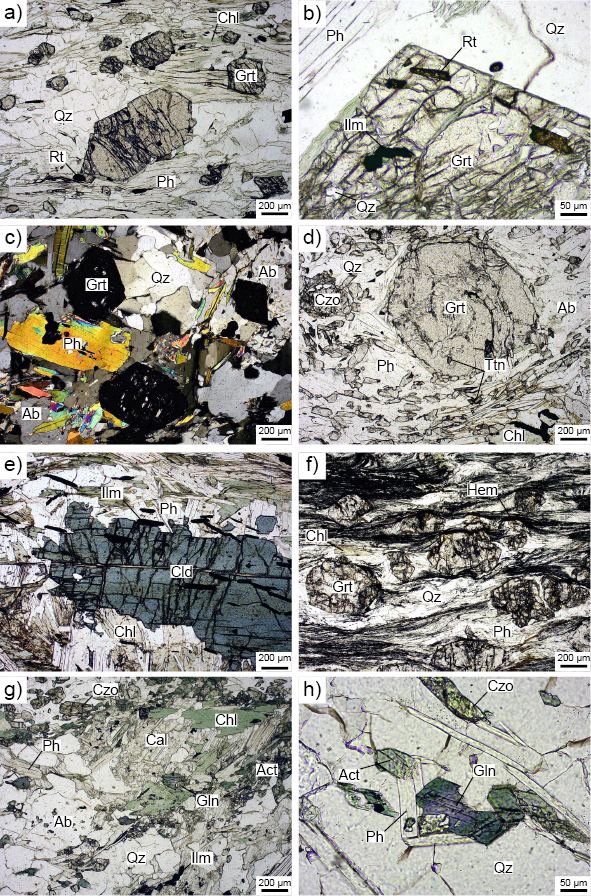
Figure 8. Polarized light photomicrographs of representative metasedimentary rocks from the high-pressure–low-temperature unit showing typical microstructural features and mineral assemblages. (a) Garnet porphyroblasts within a matrix of phengite-quartz defining a spaced penetrative foliation. (b) Detail of a garnet porphyroblast showing inclusions of rutile concentrated towards the crystal rim. (c) Cross-polarized light view showing inclusion-rich crystals of albite and garnet within a granoblastic mosaic of recrystallized quartz and corroded phengite. (d) Garnet porphyroblast wrapped by a phengite-clinozoisite-albite matrix displaying a penetrative foliation. Garnet contains abundant titanite inclusions defining a spiral-shaped inclusion trail that is discontinuous with the matrix foliation. (e) Chloritoid porphyroblast rimmed by an aggregate of radiating phengite and chlorite. (f) Garnet porphyroblasts wrapped by an anastomosing phengite-chlorite-quartz-hematite foliation. (g) Granoblastic horizon with polygonal quartz, anhedral calcite and albite, and decussate aggregates of phengite-chlorite-amphibole-clinozoisite in a glaucophane-bearing calc-schist. (h) Quartz-rich domain that contains relic glaucophane rimmed by green amphibole in a calc-schist. Ab: albite, Act: actinolite, Cal: calcite, Chl: chlorite, Cld: chloritoid, Czo: clinozoisite, Gln: glaucophane, Grt: garnet, Hem: hematite, Ilm: ilmenite, Ph: phengite, Qz: quartz, Rt: rutile, Ttn: titanite.
Albite-phengite schist
Albite-phengite schists are composed of phengite, quartz, albite, ±garnet, ±clinozoisite, and ±chlorite (Figures 8c, 8d). Accessory minerals comprise ilmenite, tourmaline, titanite, apatite, zircon, ±zoisite, ±rutile, ±calcite, ±amphibole and ±monazite. Albite characteristically lacks twinning and can be seen as inclusion-rich (clinozoisite, titanite, phengite) matrix aggregates (Figure 8c), augen poikiloblasts, or post-kinematic (D2) grains. Some rare albite films around phengite are locally present. Clinozoisite-rich (≤20 modal%) albite-phengite schists are characterized by aligned aggregates of clinozoisite, phengite, and titanite (rutile is rare), which are also present as spiral-shaped inclusion trails within garnet (Figure 8d).
Garnet-chloritoid-phengite schist
Garnet-chloritoid-phengite schists contain the characteristic assemblage phengite, quartz, garnet, chloritoid, ±paragonite, and ±chlorite, with accessory ilmenite, rutile, apatite, zircon, ±albite, ±tourmaline, and ±titanite. These schists overall have a strong foliation defined by anastomosing bands of coarse-grained phengite (commonly crenulated) and lenticular aggregates of polygonal quartz, which wraps around cm-sized porphyroblasts of garnet and chloritoid. Chlorite forms either elongated flakes replacing phengite or radiating clusters adjacent to foliation surfaces. Garnet porphyroblasts (0.5–2 cm) range from euhedral to anhedral and contain inclusions of ilmenite, rutile, and quartz. Composite coronas of chlorite and titanite surround garnet porphyroblasts. Chloritoid (0.3–2.5 cm) typically occurs as anhedral to subhedral porphyroblasts that are rimmed and partially replaced by a corona of radial crystals of white mica and chlorite (Figure 8e). Elongated inclusions of ilmenite intergrown with rutile are common in chloritoid. Frequently, both garnet and chloritoid are surrounded by strain shadows and display inclusion trail patterns reflecting a pre-kinematic character regarding D2 foliation. Albite, if present, forms lenticular aggregates enclosing vermicular quartz and chlorite.
Garnet-hematite-phengite schist
Garnet-hematite-phengite schists are fine-grained rocks containing the mineral assemblage phengite, quartz, hematite, garnet, chlorite, and ±albite (Figure 8f). Rutile, apatite, tourmaline, ±sulfide, and ±stilpnomelane constitute common accessory phases. This rock type displays a penetrative fabric defined by an anastomosing phengite-chlorite-quartz transposition foliation (D2) that can be seen to develop an incipient D3 crenulation cleavage. Garnet occurs as subhedral to anhedral (locally skeletal) porphyroblasts (≤5 mm) with inclusions of quartz, hematite, and ±rutile, which are either randomly distributed or define inclusion trails sparsely continuous with the external foliation. Garnet also forms crystal aggregates or even garnetite domains up to 2 cm in size. Chlorite generally replaces garnet along its edges and fractures. Hematite lamellae (specularite) are commonly intergrown within phengite-rich bands and occur oriented parallel to the dominant D2 foliation.
Glaucophane-bearing calc-schist
Glaucophane-bearing calc-schist is an unusual lithology in the HP-LT unit. It contains a diagnostic HP-LT mineral assemblage comprising albite, phengite, quartz, epidote-clinozoisite, calcite, green-blue amphibole, glaucophane, chlorite, and ±garnet (Figure 8g), with ilmenite, titanite, rutile, and apatite as accessory minerals. At outcrop scale, the appearance of this rock type is similar to that of the associated blueschists, but it is distinguished by notably higher abundances of phengite, quartz, and calcite (all between 10 and 20 modal%). The microstructure is defined by semi-continuous bands of aligned epidote-clinozoisite, phengite, amphibole, and chlorite, alternating with lenses of polygonal quartz as well as with albite-rich grano-lepidoblastic domains. Untwinned albite commonly forms rounded, inclusion-rich (epidote-clinozoisite and phengite) porphyroblasts up to 2 mm in diameter. Calcite is regularly distributed through the rock as anhedral (in places cuspate) grains of variable size. Glaucophane occurs as relic cores within green-blue sodic-calcic amphibole (Figure 8h), and more rarely, as anhedral tiny grains.
HP-MT unit
Garnet-quartz-phengite schist
Garnet-quartz-phengite schists have the mineral assemblage phengite, quartz, garnet, ±plagioclase, ±chlorite, and ±paragonite. Common accessory minerals are ilmenite, rutile, epidote-clinozoisite, tourmaline, apatite, zircon, ±magnetite, ±biotite, and ±monazite. This rock type displays garnet porphyroblasts (up to 2.5 cm) in a foliated matrix mainly consisting of phengite and quartz (Figures 9a, 9b). This texture frequently alternates at the mm- to cm- scale with bands of granoblastic plagioclase-quartz aggregates. Garnet cores are generally inclusion-rich (Figure 9c), although many schists contain relatively small garnet grains almost free of inclusions (Figures 9b, 9d). Cores mainly contain quartz and ilmenite inclusions (in places with skeletal textures) and rims may include quartz, rutile, and phengite (Figures 9c, 9e). Phengite occurs either as lepidoblastic aggregates or individual fish-shaped flakes that commonly contain inclusions of ilmenite and rutile. Rutile in the rock matrix range from elongated to equant (in places twinned) grains up to 0.5 mm in size, which are usually rimmed by ilmenite. Plagioclase, if present, typically displays polysynthetic twinning and ranges from albite to oligoclase, according to the Michel-Levy method. Chlorite is a retrogression phase, partially replacing garnet and phengite.
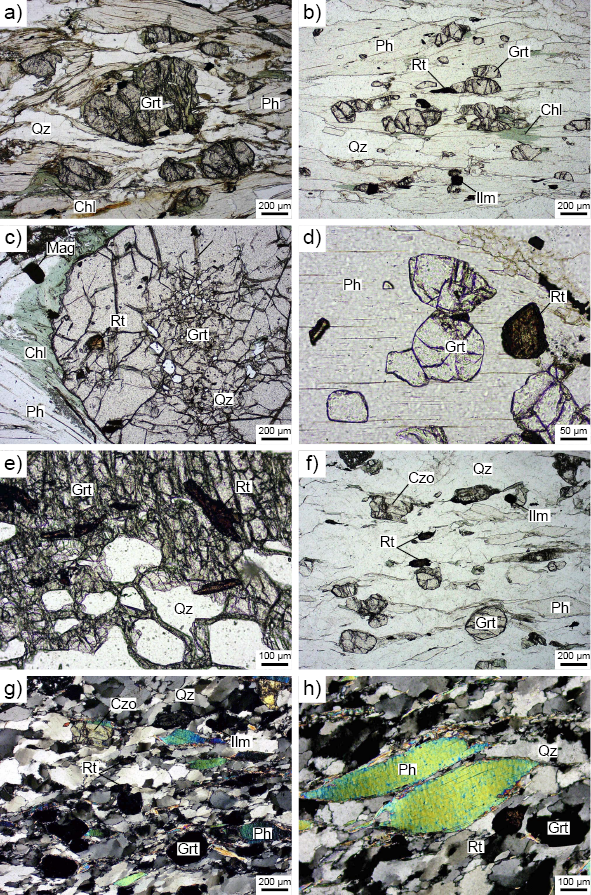
Figure 9. Polarized light photomicrographs of representative metasedimentary rocks from the high-pressure–medium-temperature unit showing typical microstructures and assemblages. (a) Medium-grained garnet-quartz-phengite schist showing anhedral to subhedral garnet porphyroblasts in a matrix of aligned quartz and phengite. (b) Fine-grained aggregates of garnet in textural equilibrium with phengite, quartz, and rutile. (c) Detail of a coarse-grained garnet poikiloblast containing inclusions of quartz, ilmenite (opaque), and rutile. Garnet is partially replaced by chlorite-magnetite aggregates. (d) Phengite porphyroblast with inclusions of rutile and inclusion-free garnet. (e) Detail of a garnet poikiloblast displaying skeletal texture at the core and rutile inclusions concentrated towards the crystal rim. (f) Fine-grained quartz-rich gneiss with small porphyroblasts of garnet and clinozoisite, anhedral rutile grains and aligned phengite. (g) Cross-polarized light view of (f) showing a matrix polycrystalline quartz with polygonal to irregular grain boundaries. (h) Fish shaped phengite, as well as granular rutile and garnet within a matrix of quartz with irregular grain boundaries (cross-polarized light). Chl: chlorite, Czo: clinozoisite, Grt: garnet, Ilm: ilmenite, Mag: magnetite, Ph: phengite, Qz: quartz, Rt: rutile.
Quartz-rich gneiss and quartzite
A considerable volume of the HP-MT metasedimentary rocks contains above 40–50 modal% quartz, ranging from quartz-rich gneiss to quartzite. The most common mineral assemblage of these rocks consists of quartz, phengite, ±garnet, ±clinozoisite, ±plagioclase, and ±chlorite. Ilmenite, rutile, tourmaline, apatite, zircon, and ±monazite represent common accessory phases. The texture is dominated by polycrystalline quartz aggregates mostly showing irregular grain boundaries, undulose extinction, and subgrains. These aggregates alternate with thin (μm- to mm-scale) cleavage domains (D1-D2) of aligned phengite (Figures 9f, 9g). Phengite also occurs as individual fish-shaped flakes (up to 5 mm long) displaying crenulation and/or undulose extinction (Figure 9h). Garnet forms relatively small (≤3 mm) euhedral to subhedral porphyroblasts with sparse inclusions of quartz, ilmenite, and rutile. Clinozoisite occurs as subhedral prismatic crystals and elongated grains aligned parallel to the foliation and is in textural equilibrium with phengite and garnet.
DISCUSSION AND CONCLUSIONS
The study of the Piaxtla HP suite has been hindered by problems of conflicting nomenclature and failed attempts to correlate rocks, structures, and events across the unit as a whole. Successive geological and geochronological studies gave some lithodemic names a chronological sense but, as work advanced, fitting events into a coherent regional framework became increasingly difficult (e.g., Ortega-Gutiérrez et al., 1999; Murphy et al., 2006; Vega-Granillo et al., 2007). The available data indicate that this suite reflects subduction zone metamorphism of Mississippian age that affected a composite sequence of interleaved metasedimentary and metaigneous units (Middleton et al., 2007; Keppie et al., 2010; Estrada-Carmona et al., 2016). Accordingly, in its most recent meaning, the term "Piaxtla suite" comprises all rock sequences within the HP suite (Keppie et al., 2012b). From a metamorphic point of view, however, contrasts in mineral assemblages and P-T estimates (e.g., Ortega-Gutiérrez, 1974; Meza-Figueroa et al., 2003; Vega-Granillo et al., 2007; Galaz E. et al., 2013; Hernández-Uribe et al., 2019; Hernández-Uribe, 2022) imply that for the overall architecture and evolution of the HP belt to be understood, the spatial distribution of the metamorphic conditions must be determined. Geological mapping and petrographic descriptions presented in this work show that rocks and mineral assemblages within the Piaxtla HP suite are not randomly arranged (i.e., mixed rock bodies) but systematically and predictably distributed across the region. Accordingly, the suite can be divided into two HP units of distinct metamorphic grade and potentially independent metamorphic evolutions.
The blueschist-bearing HP-LT unit is exposed for the most part in the Mimilulco-Las Casitas area and correlates with similar sequences reported in the Ixcamilpa region (southern Acatlán Complex) (Vega-Granillo et al., 2007; Ramos-Arias & Keppie, 2011). Blueschists were formerly interpreted to represent prograde relics of the eclogite-facies metamorphism of the Piaxtla HP suite (Meza-Figueroa et al., 2003). In consequence, garnet amphibolites in the Mimilulco area have been commonly considered to be "eclogites" or "retrogressed eclogites" (e.g., Talavera-Mendoza et al., 2005; Vega-Granillo et al., 2007; Hernández-Uribe et al., 2019; Hernández-Uribe, 2022) though this has not yet been proven to be the case. For instance, although Meza-Figueroa et al. (2003) reported "omphacite" in "eclogites" from this area, their representative clinopyroxene compositions actually correspond to aluminian augite (according to Morimoto, 1988). No subsequent studies, including ours, have corroborated the existence of omphacite in these rocks. Conversely, field relationships described in this work indicate that retrogression in the Mimilulco-Las Casitas area led to the partial or complete transformation of garnet-bearing blueschists into green garnet amphibolite (Figure 4f). We still notice that the occurrence of garnet amphibolites with abundant zoisite relics in the Mimilulco area might suggest a former assemblage with zoisite ± glaucophane ± omphacite, which has been experimentally produced at the blueschist-eclogite transition (Cheng & Jenkins, 2021). The epidote-blueschist facies metamorphism that characterizes this area is consistent with the development of the diagnostic HP assemblage garnet + chloritoid + phengite + rutile in the most aluminous metasedimentary rocks. Similar assemblages have been reported in metapelites from several subduction complexes that underwent HP metamorphism at temperatures not higher than 550–600 °C
(e.g., Vuichard & Ballèvre, 1988; Maldonado et al., 2016; Negulescu et al., 2018). Therefore, metasediments within the HP-LT unit share a common metamorphic history with the enclosed blueschists and, as a whole, represent a coherent crustal fragment. Outside the Mimilulco-Las Casitas area, the HP suite is characterized by containing variably retrogressed eclogites, which can be considered as indicatory of the HP-MT unit. Although the quartz-rich nature of metasedimentary rocks within this unit prevented the formation of diagnostic low-variance mineral assemblages, the common association of garnet + phengite + rutile and the occurrence of twinned plagioclase are indicative of HP-MT metamorphic conditions. Consequently, metasediments from the HP-MT unit might have followed the same P-T trajectory as the hosted eclogites.
We presented several lines of evidence suggesting that the Piaxtla HP suite includes two differentiable tectonometamorphic units, which constitute a first-order structure of the suite. This implies that the HP suite does not represent a single, along-strike continuous belt, but instead, an assemblage of semi-coherent slices tectonically juxtaposed. Unfortunately, the main boundary, which is inferred to be located between the Mimilulco and Organal areas, is covered by Cenozoic deposits (Figure 1). In the area of Piaxtla-Tecomatlán, however, the possible contact between both units is defined by an apparent NW-vergent thrust fault (Figure 3 section D-D', Figure 6), similar to that documented in the Ixcamilpa area (Ramos-Arias & Keppie, 2011). The available geochronological data suggest that this suite as a whole recorded Mississippian subduction-zone metamorphism with near-peak ages ranging from ca. 353 and 344 Ma (Middleton et al., 2007; Keppie et al., 2010; Estrada-Carmona et al., 2016). We consider that the LT and MT units could have evolved at the same convergent limit and be more or less contemporary. Therefore, future studies will have to focus on evaluating the mechanisms and timing of the assembly of this composite HP suite.
SUPPLEMENTARY MATERIAL
Supplementary Table S1 “Rock samples from the Piaxtla high-pressure suite”, can be found on the Abstract's preview page of this paper < http://dx.doi.org/10.22201/igc.20072902e.2025.1.1844>.
Acknowledgments: We want to acknowledge V. Ortiz-Olvera and L. Brito-Mejía for helping in the fieldwork. We would like to express our gratitude to Uwe Martens and an anonymous reviewer for their constructive feedback, as well as to Associated Editor Luca Ferrari and Technical Editor Teresa Orozco-Esquivel for their meticulous editorial oversight.
Funding:This work was supported by the PAPIIT-DGAPA UNAM projects IA102523 and IN114223 granted to R. Maldonado and L. Solari, respectively.
Author Contributions:Roberto Maldonado: Conceptualization, Methodology, Investigation. Writing-Original Draft, Visualization, Funding acquisition. Mariano Elías-Herrera: Investigation, Review & Editing. Guillermo Espejo-Bautista: Investigation, Visualization, Writing–Review & Editing. Israel Ramírez-Serdán: Investigation, Review & Editing. Duban Esteban Gomez-Gomez: Investigation. Angela Prado-Ordoñez: Investigation. Consuelo Macías-Romo: Investigation. José Luis Sánchez-Zavala: Investigation.
Data availability statement: All the data that support the ideas presented in the manuscript are fully available, either within this article or in the supplementary material, to those who could be interested in reproducing the results.
Declaration of competing interests: The authors declare that they have no known competing financial interests or personal relationships that could have appeared to influence the work reported in this paper.
REFERENCES
Agard, P., Plunder, A., Angiboust, S., Bonnet, G., & Ruh, J. (2018). The subduction plate interface: rock record and mechanical coupling (from long to short timescales). Lithos, 320-321, 537–566. https://doi.org/10.1016/j.lithos.2018.09.029
Balestro, G., Nosenzo, F., Cadoppi, P., Fioraso, G., Groppo, C., & Festa, A. (2020). Geology of the southern Dora-Maira Massif: insights from a sector with mixed ophiolitic and continental rocks (Valmala tectonic unit, Western Alps). Journal of Maps, 16(2), 736–744. https://doi.org/10.1080/17445647.2020.1824825
Cheng, N., & Jenkins, D.M. (2021). Experimental study of metamorphic reactions and dehydration processes at the blueschist–eclogite transition during warm subduction. Journal of Metamorphic Geology, 39(1), 39–56. https://doi.org/10.1111/jmg.12560
Compagnoni, R., Rolfo, F., Groppo, C., Hirajima, T., & Turello, R. (2012). Geological map of the ultra-high pressure Brossasco-Isasca unit (Western Alps, Italy). Journal of Maps, 8(4), 465–472. https://doi.org/10.1080/17445647.2012.744367
Estrada-Carmona, J., Weber, B., Scherer, E.E., Martens, U., & Elías-Herrera, M. (2016). Lu- Hf geochronology of Mississippian high-pressure metamorphism in the Acatlán Complex, southern México. Gondwana Research, 34, 174–186. https://doi.org/10.1016/j.gr.2015.02.016
Galaz, E., G., Keppie, J. D., Lee, J. K. W., & Ortega-Rivera, A. (2013). A high-pressure folded klippe at Tehuitzingo on the western margin of an extrusion zone, Acatlán Complex, southern México. Gondwana Research, 23(2), 641–660. https://doi.org/10.1016/j.gr.2012.04.011
Hernández-Uribe, D. (2022). A re-evaluation of the peak P–T conditions of eclogite-facies metamorphism of the Paleozoic Acatlán Complex (Mexico) reveals deeper subduction. Scientific Reports, 12(1), 21399. https://doi.org/10.1038/s41598-022-25992-8
Hernández-Uribe, D., Gutiérrez-Aguilar, F., Mattinson, C. G., Palin, R. M., & Neill, O. K. (2019). A new record of deeper and colder subduction in the Acatlán complex, Mexico: Evidence from phase equilibrium modelling and Zr-in-rutile thermometry. Lithos, 324–325, 551–568. https://doi.org/10.1016/j.lithos.2018.10.003
Hinojosa-Prieto, H. R., Nance, R. D., Keppie, J. D., Dostal, J. V., Ortega-Rivera, A., & Lee, J. K. W. (2008). Ordovician and Late Paleozoic–Early Mesozoic tectonothermal history of the La Noria area, northern Acatlán Complex, southern Mexico: Record of convergence in the Rheic and paleo-Pacific Oceans. Tectonophysics, 461(1–4), 324–342. https://doi.org/10.1016/j.tecto.2008.06.002
Keppie, J. D., Nance, R. D., Ramos-Arias, M. A., Lee, J. K. W., Dostal, J., Ortega-Rivera, A., & Murphy, J. B. (2010). Late Paleozoic subduction and exhumation of Cambro- Ordovician passive margin and arc rocks in the northern Acatlán Complex, southern Mexico: Geochronological constraints. Tectonophysics, 495(3–4), 213–229. https://doi.org/10.1016/j.tecto.2010.09.019
Keppie, J. D., Dostal, J., Murphy, J. B., Galaz-Escanilla, G., Ramos-Arias, M. A., & Nance, R. D. (2012a). High pressure rocks of the Acatlán Complex, southern Mexico: Large- scale subducted Ordovician rifted passive margin extruded into the upper plate during the Devonian–Carboniferous. Tectonophysics, 560–561, 1–21. https://doi.org/10.1016/j.tecto.2012.06.015
Keppie, J. D., Nance, R. D., Dostal, J., Lee, J. K. W., & Ortega-Rivera, A. (2012b). Constraints on the subduction erosion/extrusion cycle in the Paleozoic Acatlán Complex of southern Mexico: Geochemistry and geochronology of the type Piaxtla Suite. Gondwana Research, 21(4), 1050–1065. https://doi.org/10.1016/j.gr.2011.07.020
Maldonado, R., Ortega-Gutiérrez, F., & Hernández-Uribe, D. (2016). Garnet–chloritoid–paragonite metapelite from the Chuacús Complex (Central Guatemala): new evidence for continental subduction in the North America–Caribbean plate boundary. European Journal of Mineralogy, 28(6), 1169–1186. https://doi.org/10.1127/ejm/2016/0028-2578
Meza-Figueroa, D., Ruiz, J., Talavera-Mendoza, O., & Ortega-Gutierrez, F. (2003). Tectonometamorphic evolution of the Acatlan Complex eclogites (southern Mexico). Canadian Journal of Earth Sciences, 40(1), 27–44. https://doi.org/10.1139/e02-093
Middleton, M., Keppie, J. D., Murphy, J. B., Miller, B. V., Nance, R. D., Ortega-Rivera, A., & Lee, J. K. W. (2007). P-T-t constraints on exhumation following subduction in the Rheic Ocean from eclogitic rocks in the Acatlán Complex of southern México. In The Evolution of the Rheic Ocean: From Avalonian-Cadomian Active Margin to Alleghenian-Variscan Collision. Geological Society of America. https://doi.org/10.1130/2007.2423(25)
Middleton, M., Keppie, J. D., Murphy, J. B., Miller, B. V., Nance, R. D., Ortega-Rivera, A., & Lee, J. K. W. (2007). P-T-t constraints on exhumation following subduction in the Rheic Ocean from eclogitic rocks in the Acatlán Complex of southern México. In U. Linnemann, R. D. Nance, P. Kraft, & G. Zulauf (Eds.), The Evolution of the Rheic Ocean: From Avalonian-Cadomian Active Margin to Alleghenian-Variscan Collision. doi:10.1130/2007.2423(25)
Morimoto, N. (1988). Nomenclature of Pyroxenes. Mineralogy and Petrology, 39(1), 55–76. https://doi.org/10.1007/BF01226262
Murphy, J. B., Keppie, J. D., Nance, R. D., Miller, B. V., Dostal, J., Middleton, M., Fernandez-Suárez, J., Jeffries, T. E., & Storey, C. D. (2006). Geochemistry and U–Pb protolith ages of eclogitic rocks of the Asís Lithodeme, Piaxtla Suite, Acatlán Complex, southern Mexico: tectonothermal activity along the southern margin of the Rheic Ocean. Journal of the Geological Society, 163(4), 683–695. https://doi.org/10.1144/0016-764905-108
Nance, R. D., Keppie, J. D., Miller, B. V., Murphy, J. B., & Dostal, J. (2009). Palaeozoic palaeogeography of Mexico: constraints from detrital zircon age data. Geological Society, London, Special Publications, 327(1), 239–269. https://doi.org/10.1144/SP327.1
Negulescu, E., Săbău, G., & Massonne, H.-J. (2018). Growth of chloritoid and garnet along a nearly isothermal burial path to 70 km depth: an example from the Bughea Metamorphic Complex, Leaota Massif, South Carpathians. Mineralogy and Petrology, 112(4), 535–553. https://doi.org/10.1007/s00710-017-0552-9
Ortega-Gutiérrez, F. (1974). Nota preliminar sobre las eclogitas de Acatlán. Boletín de la Sociedad Geológica Mexicana, (35), 1–6.
Ortega-Gutiérrez, F. (1978). Estratigrafía del Complejo Acatlán en la Mixteca baja, estados de Puebla y Oaxaca. Revista Mexicana de Ciencias Geológicas, 2(2), 112–131.
Ortega-Gutiérrez, F., Elías-Herrera, M., Morán-Zenteno, D. J., Solari, L., Weber, B., & Luna- González, L. (2018). The pre-Mesozoic metamorphic basement of Mexico, 1.5 billion years of crustal evolution. Earth-Science Reviews, 183, 2–37. https://doi.org/10.1016/j.earscirev.2018.03.006
Ortega-Gutiérrez, F., Elías-Herrera, M., Reyes-Salas, M., Macías-Romo, C., & López, R. (1999). Late Ordovician–Early Silurian continental collisional orogeny in southern Mexico and its bearing on Gondwana-Laurentia connections. Geology, 27(8), 719–722. https://doi.org/10.1130/0091-7613(1999)027<0719:LOESCC>2.3.CO;2
Proenza, J. A., Ortega-Gutiérrez, F., Camprubí, A., Tritlla, J., Elías-Herrera, M., & Reyes- Salas, M. (2004). Paleozoic serpentinite-enclosed chromitites from Tehuitzingo (Acatlán Complex, southern Mexico): a petrological and mineralogical study. Journal of South American Earth Sciences, 16(8), 649–666. https://doi.org/10.1016/j.jsames.2003.12.003
Ramos-Arias, M. A., & Keppie, J. D. (2011). U–Pb Neoproterozoic–Ordovician protolith age constraints for high- to medium-pressure rocks thrust over low-grade metamorphic rocks in the Ixcamilpa area, Acatlán Complex, southern Mexico. Canadian Journal of Earth Sciences, 48(1), 45–61. https://doi.org/10.1139/E10-082
Ramos-Arias, M. A., Keppie, J. D., Ortega-Rivera, A., & Lee, J. W. K. (2008). Extensional Late Paleozoic deformation on the western margin of Pangea, Patlanoaya area, Acatlán Complex, southern Mexico: Tectonophysics, 448(1–4), 60–76. https://doi.org/10.1016/j.tecto.2007.11.023
Ramos-Arias, M. A., Keppie, J. D., Lee, J. K. W., & Ortega-Rivera, A. (2012). A Carboniferous high-pressure klippe in the western Acatlán Complex of southern México: implications for the tectonothermal development and palaeogeography of Pangea: International Geology Review, 54(7), 779–798. https://doi.org/10.1080/00206814.2011.580634
Sánchez-Zavala, J. L., Ortega-Gutiérrez, F., Keppie, J. D., Jenner, G. A., Belousova, E., & Maciás-Romo, C. (2004), Ordovician and Mesoproterozoic Zircons from the Tecomate Formation and Esperanza Granitoids, Acatlán Complex, Southern Mexico: Local Provenance in the Acatlán and Oaxacan Complexes. International Geology Review, 46(11), 1005–1021. https://doi.org/10.2747/0020-6814.46.11.1005
Silva-Romo, G., Mendoza-Rosales, C. C., Campos-Madrigal, E., Hernández-Marmolejo, Y. B., de la Rosa-Mora, O. A., de la Torre-González, A. I., Bonifacio-Serralde, C., López-García, N., & Nápoles-Valenzuela, J. I. (2018). Timing of the Cenozoic basins of Southern Mexico and its relationship with the Pacific truncation process: Subduction erosion or detachment of the Chortís block. Journal of South American Earth Sciences, 83, 178–194. https://doi.org/10.1016/j.jsames.2018.01.007
Talavera-Mendoza, O., Ruiz, J., Gehrels, G. E., Meza-Figueroa, D. M., Vega-Granillo, R., & Campa-Uranga, M. F. (2005). U–Pb geochronology of the Acatlán Complex and implications for the Paleozoic paleogeography and tectonic evolution of southern Mexico. Earth and Planetary Science Letters, 235(3), 682–699. https://doi.org/10.1016/j.epsl.2005.04.013
Vega-Granillo, R., Talavera-Mendoza, O., Meza-Figueroa, D., Ruiz, J., Gehrels, G. E., López-Martínez, M., & De La Cruz-Vargas, J. C. (2007). Pressure-temperature-time evolution of Paleozoic high-pressure rocks of the Acatlán Complex (southern Mexico): Implications for the evolution of the Iapetus and Rheic Oceans. Geological Society of America Bulletin, 119(9–10), 1249–1264. https://doi.org/10.1130/B226031.1
Vuichard, J. P., & Ballèvre, M. (1988). Garnet–chloritoid equilibria in eclogitic pelitic rocks from the Sesia zone (Western Alps): their bearing on phase relations in high pressure metapelites. Journal of Metamorphic Geology, 6(2), 135–157. https://doi.org/10.1111/j.1525-1314.1988.tb00413.x
Editors:
Natalia Pardo Villaveces
Luca Ferrari
Copyright
© 2025 The Author(s).
This is an open-access article published and distributed by the Universidad Nacional Autónoma de México under the terms of a Creative Commons Attribution 4.0 International License (CC BY) which permits unrestricted use, distribution, and reproduction in any medium, provided the original author and source are credited.
